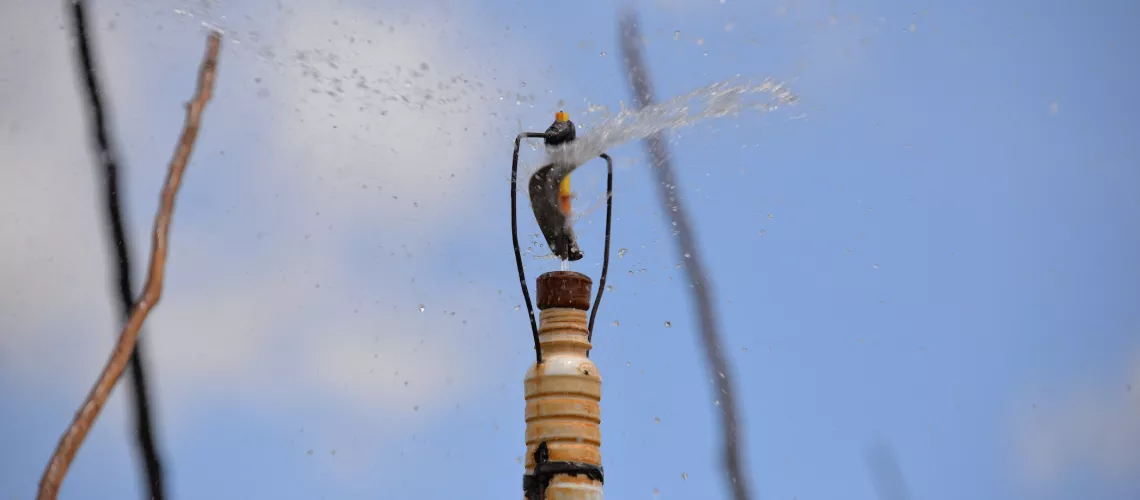A quiet revolution in irrigation offers a key to recovery
By Karin Krchnak & Pieter Waalewijn

The coronavirus (COVID-19) pandemic is changing how we interact, not just with each other, but also with the planet. The worldwide disruption of the status quo has prompted a ubiquitous question: when this crisis is over, how can we build back better?
The economic fallout has been immense, with dire consequences for poverty and welfare, particularly in developing countries. Conservative estimates suggest that the economic contraction will push 48 million to 135 million people into poverty worldwide.1 The World Food Programme warns of a potential doubling of acute food insecurity in low- and middle-income countries in 2020.
For agriculture, which is at the nexus of livelihoods, environment, and global food security, this question has far-reaching implications. Around 65% of poor working adults make a living through agriculture, while the sector alone accounts for 70% of freshwater withdrawals worldwide.
In this context, what does it mean to build back better?
In developing countries, income shocks have severely affected farmers and informal workers in rural areas, and households are net buyers of agricultural produce. In the short term, recovery means safeguarding local food access and food security by ensuring the functioning of value chains and promoting the production and availability of diversified, safe, and nutritious food for all.
In the medium to long term, recovery will mean investing in climate-smart solutions that increase resilience to shocks for farmers and food systems. The pandemic has also exposed critical weaknesses in the resilience of the natural systems underpinning agriculture, wrought by decades of deforestation, soil degradation, water and soil mismanagement, biodiversity loss, and climate change. Building back better means, in part, building back greener, recognizing the interconnections between people and our shared environment.
A revolution already underway: farmer-led irrigation
In the longer term, it can also help safeguard domestic food security and strengthen farmers’ ability to recover from shocks and adapt to a changing environment.
FLID complements yet stands in contrast to the large-scale public schemes that dominated irrigation development throughout the 20th century. Those tended to be centralized bureaucracies, with water-supply operations controlled or overseen by a central or local government authority. FLID is an evolution in the other direction, filling the gaps where large-scale operations haven’t reached. It’s not just a typology, but a process – one in which farmers, either on their own or in groups, but often in cooperation with outside partners, develop irrigation solutions tailored to their needs and priorities.
Despite being minimally acknowledged and accounted for in official registries of irrigation infrastructure, and despite receiving little or no formal support, FLID is already a large and fast-growing part of the irrigation footprint in Africa, Asia, Europe, Latin America, and the United States. It creates a direct pathway for helping millions of farmers who live in poverty and need immediate support. In the recovery from COVID-19, it also offers higher economic returns alongside quicker turnaround times as compared to large-scale models for delivery of irrigation.
Removing barriers to financing, enabling access to technology and markets, building capacity, and knowledge transfer are powerful ways to accelerate FLID. This can provide on-demand and more reliable irrigation water at a time when rural livelihoods are already threatened by conflicts, climate shocks, desert locust outbreaks, and economic distress –all compounded by COVID-19 hazards.
How FLID can support pandemic recovery
COVID-19 has triggered a cascade of job losses, with many urban dwellers likely to return to rural areas where farming offers one of the few opportunities to increase food security and household income. Every intervention to mitigate pandemic impacts is important, but those with quick returns even more so. Given that FLID is already growing, there’s potential to quickly intensify and expand its footprint by building on this momentum. FLID interventions – with a focus on promoting knowledge exchange, driving technological innovation, and facilitating financing and value-chain linkages – are relatively low-cost per hectare compared with large-scale irrigation investments. This can help generate more rural jobs and access to food at a time when these are most needed.
Farmers’ own investments hold high potential to increase incomes both for themselves and others in irrigated value chains. Irrigated production also generally ensures stable and increased availability of locally grown food, in particular vegetables and leafy greens on the local and regional market, thus improving nutrition not just for farm families but communities in general.
The short-term benefits from FLID – strengthening self-reliance and building connections across supply chains, improving the sustainability of local food systems, promoting job creation, increasing rural prosperity, and strengthening local water stewardship – all help mitigate the impacts of future shocks. Irrigated agriculture is, on average, at least twice as productive per unit of land as rainfed agriculture, thus improving resource efficiency and allowing intensified production. This contributes to agriculture-led economic growth, which is two to four times more effective at reducing poverty and food insecurity than growth in other sectors.
As we ask “how to build back better,” there’s value in building on what has proved successful in the past. Through FLID, farmers across the world have shown that they are best placed to develop local solutions to their challenges. In part two, we will explore how the development community can help scale up and accelerate FLID to support COVID-19 recovery and a more resilient future.
1 The estimate depends on the poverty line used (48 million new poor, using the $1.90/day poverty line for all countries; and 135 million new poor, using $1.90/day for low- income, $3.20/day for lower-middle- income, and $5.50/day for upper-middle- and high-income countries). This will make 2020 the first year since 1998 that the global rate of poverty will increase.
